Time to COP on to Climate Change
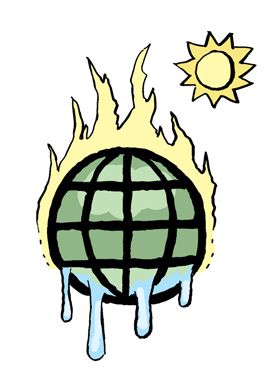
This week, the COP26 UN Climate Change Conference is taking place in Glasgow. This is a summit that will bring parties together to accelerate action towards the goals of the Paris Agreement and the UN Framework Convention on Climate Change.
The Paris Agreement was signed at the Paris climate conference (COP21) in December 2015. 195 countries adopted the first ever legally binding global climate deal. This agreement entered into force in 2020 with the aim to keep global warming below 2°C by 2100. Countries agreed:
a long-term goal of keeping the increase in global average temperature to well below 2°C above pre-industrial levels;
to aim to limit the increase to 1.5°C, since this would significantly reduce risks and the impacts of climate change;
to come together every five years to set more ambitious targets as required by science;
to provide continued and enhanced international support for adaptation to developing countries.
However, at a global level countries are not making the progress required to meet the legally binding targets in the Paris Agreement.

The Sixth Assessment Report of the Intergovernmental Panel on Climate Change ‘Climate Change 2021: the Physical Science Basis’ published in advance of COP26 contains very worrying findings.
Scientists are observing changes (unprecedented in thousands, if not hundreds of thousands of years) in the Earth’s climate in every region and across the whole climate system.
Some of the changes already set in motion—such as continued sea level rise—are irreversible over hundreds to thousands of years. Unless there are immediate, rapid and large-scale reductions in greenhouse gas emissions, limiting warming to close to 1.5°C or even 2°C will be beyond reach.
The report projects that in the coming decades climate changes will increase in all regions. For 1.5°C of global warming, there will be increasing heat waves, longer warm seasons and shorter cold seasons.
At 2°C of global warming, heat extremes would more often reach critical tolerance thresholds for agriculture and health, the report shows.
The report shows that emissions of greenhouse gases from human activities are responsible for approximately 1.1°C of warming since 1850-1900, and finds that averaged over the next 20 years, global temperature is expected to reach or exceed 1.5°C of warming.
However human actions still have the potential to determine the future course of climate. The evidence is clear that carbon dioxide is the main driver of climate change, even as other greenhouse gases and air pollutants also affect the climate.
Stabilising the climate will require strong, rapid, and sustained reductions in greenhouse gas emissions, and reaching net zero CO2 emissions. Limiting other greenhouse gases and air pollutants, especially methane, could have benefits both for health and the climate.
Immediate, strong, and sustained reductions in emissions of carbon dioxide and other greenhouse gases are required to limit climate change. This would provide initial benefits benefits for air quality quickly, it could take 20-30 years to see global temperatures stabilise due to a lack of progress in reducing human-caused greenhouse gas emissions.
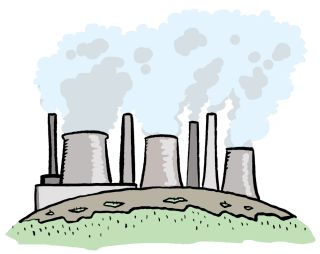
The United in Science 2021 report, also published before COP26, found that five years after the adoption of the Paris Agreement, the emissions gap is as large as ever. The COVID-19 crisis offers only a short-term reduction in global emissions. It will not significantly reduce emissions by 2030 unless countries pursue an economic recovery that incorporates strong decarbonization.
In fact, CO2 emissions have largely bounced back to pre-pandemic levels. Fossil CO2 emissions – coal, oil, gas and cement – peaked in 2019, followed by an extraordinary drop of 5.6% in 2020 due to the COVID-19 pandemic. Based on preliminary estimates, global emissions in the power and industry sectors were already at the same level or higher in January-July 2021 than in the same period in 2019.
The report finds that reducing atmospheric methane in the short term could support the achievement of the Paris Agreement. This does not reduce the need for strong, rapid and sustained reductions in CO2 and other greenhouse gases. So short and long term strategies are required. But either way, we have to reduce all of our emissions.
According to this report for COP26, to be a turning point, all countries need to commit to net zero emissions by 2050, backed up by concrete long-term strategies, and enhanced Nationally Determined Contributions which collectively cut global emissions by 45 per cent by 2030, compared to 2010 levels.
Finally, the United Nations Emissions Programme report ‘The Heat is on’ published in October issues a stark warning. The Emissions Gap Report 2021 shows that new national climate pledges combined with other mitigation measures put the world on track for a global temperature rise of 2.7°C by the end of the century. That is well above the goals of the Paris climate agreement and would lead to catastrophic changes in the Earth’s climate. To keep global warming below 1.5°C this century, the aspirational goal of the Paris Agreement, the world needs to halve annual greenhouse gas emissions in the next eight years.
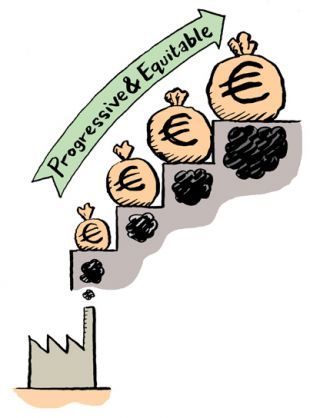
Many national climate plans delay action until after 2030. The reduction of methane emissions from the fossil fuel, waste and agriculture sectors could help close the emissions gap and reduce warming in the short term.
Latest UNEP Emissions Gap Report finds new and updated Nationally Determined Contributions only take 7.5% off predicted 2030 emissions, while 55% is needed to meet the 1.5°C Paris goal
Latest climate promises for 2030 put the world on track for a temperature rise this century of at least 2.7°C
The report finds that net-zero pledges could make a big difference. If fully implemented, these pledges could bring the predicted global temperature rise to 2.2°C, providing hope that further action could still head off the most-catastrophic impacts of climate change. However, net-zero pledges are still vague, incomplete in many cases, and inconsistent with most 2030 Nationally Determined Contributions (which is what each country actually commits to reduce its emissions by).
So that’s the global picture, but what about the National Picture. What about Ireland? What are our national commitments and targets?
The Programme for Government commits to an average 7% per annum reduction in overall greenhouse gas emissions from 2021 to 2030 (a 51% reduction over the decade), and to achieving net zero emissions by 2050.
Climate Action and Low Carbon Development (Amendment) Bill 2021 established a legally binding framework with clear targets and commitments set in law, and ensure the necessary structures and processes are embedded on a statutory basis to ensure Ireland achieves national, EU and international climate goals and obligations in the near and long term. The Bill contains a provision that the first two five-year carbon budgets proposed by the Climate Change Advisory Council should equate to a total reduction of 51% emissions over the period to 2030.
The Climate Change Advisory Council (the Council) has submitted its proposal for Ireland’s first carbon budget programme on the 25th of October. The programme is broken down into three five-year carbon budgets. Carbon budgets prescribe the maximum amount of greenhouse gases that may be emitted over a specific period of time in the State.
The first two carbon budgets in the programme provide for the 51% reduction in greenhouse gas emissions from the state by 2030 relative to 2018 as set out in the Climate Action and Low-Carbon Development (Amendment) Act.
The annual Average Percentage Change in Emissions from the first carbon budget 2021-2025 is a reduction of 4.8%, the second carbon budget 2026-2030 sees a reduction of 8.3%, and the third budget 2031-2035 sees a reduction of 3.5%.
The first carbon budget has built in the implications of the time-lag between making decisions and investments on the one hand, and on the other hand, seeing the emissions reductions come into effect.
The Climate Action Plan will set out exactly what policies will be enacted to get us there.
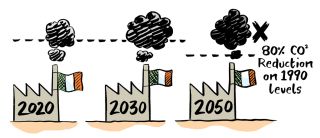
There are also European targets. As a member of the EU, Ireland has committed to legally binding emissions reduction targets in 2020 and 2030. We have committed to a 20 per cent reduction on 2005 emission levels by 2020, and a 30 per cent reduction of emissions compared to 2005 levels by 2030. Ireland will not meet the 2020 target and we are certainly not on a trajectory to make our 2030 targets. The European Commission has also committed to a net reduction in greenhouse gas emissions by at least 55% by 2030, a substantial increase on the previous target of a 40% reduction. Ireland must make a contribution to this target
Provisional greenhouse gas emissions published by the Environmental Protection Agency for 2020 show that Ireland’s greenhouse gas emissions decreased by 3.6 per cent in 2020, less than the reduction seen in 2019.
Lockdown measures in response to the COVID-19 pandemic resulted in a 15.7 per cent decrease in Transport emissions, the largest sectoral emissions reduction.
Peat fuelled electricity generation decreased by 51 per cent in 2020. Together with a 15 per cent increase in wind generation - this led to a 7.9 per cent reduction in Energy Industry emissions.
Residential greenhouse gas emissions increased by 9.0 per cent, with a substantial increase in carbon intensive fossil fuel use driven by low fuel prices and working from home.
Agriculture emissions increased by 1.4 per cent in 2020, driven by increased activity in all areas, including a 3.2 per cent increase in the number of dairy cows.
While the overall reduction in emissions of 3.6 per cent is welcome, the majority of the reduction was due to a short term decrease in transport emissions due to the Covid 19 pandemic, which is likely to be once-off.
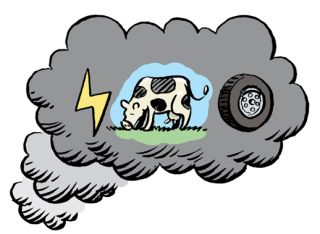
Ireland’s emissions are dominated by transport, agriculture and energy.
Irish dairy farms produce up to three time more greenhouse gas and ammonia emissions than other farming sectors, yet the dairy sector has been earmarked by Government for continued expansion. Increase in herd sizes on dairy farms is undermining any gains from more efficient and sustainable farming practices. This type of policy incoherence makes it challenging to support this sector to meet climate targets. While reducing agricultural emissions will be difficult, it is necessary. In order to do so it is vital that Food Wise 2030 reflects the Farm-to-Fork principles of the European Commission and sets ambitious targets to reduce our agricultural emissions. The Ag Climatise Strategy commits to a reduction in absolute emissions from agriculture by 2030, but does not detail a specific target, nor outline some of the difficult yet very necessary policy changes that must be introduced if absolute emissions from agriculture are to be reduced. The setting of carbon budgets, and the detailed emissions reductions required from each sector means that policy change and investment is required immediately to support farmers in the transition to a greener economy and society.
With regard to our national and international climate commitments we need to consider what agricultural policy will be best-placed to ensure Ireland meets its national and international targets: Is it a policy of agricultural expansion and increased emissions to reach additional markets, or, is it a policy of ensuring Ireland produces the food required to meet our population needs and supports the agricultural sector in the developing world to ensure they can provide the food required to meet their own population needs? These are the kinds of issues that the Climate action Plan must begin to address.
Transport is another area which faces challenging targets. Despite impact of Covid-19 restrictions in emissions from this sector in 2020, a significant amount of work needs to be done in order to reduce emissions. While emissions fell significantly in 2020 due to the impact of the pandemic, emissions in Ireland are cyclical, thus transport emissions are likely to increase again.
Road transport is just one element of transport emissions. Emissions from aviation are not taxed directly. Jet kerosene use increased by 1.2% in 2019 and is now greater than petrol use and air travel is now second only to private cars as a share of transport energy. As we begin to look at what measures are required in the Climate Action Plan we must look at the aviation sector and the policy levers that are available to ensure that it makes a contribution to our climate targets
Significant investment is needed to develop a public transport network powered by electricity and renewable energy. To encourage electric car use the national charging infrastructure must be upgraded and the tax on electric vehicles should be reduced to make them a more affordable option.
The initial investment in public transport will be substantial if it is to have the necessary effect, but the long-term social, environmental and economic benefits of such a change would greatly outweigh the cost. It is vital that the upgrade to the public transport network has a strong focus on connectivity to ensure that people travelling from rural or regional areas to urban centres are encouraged to do so by public transport.
Energy is the third largest driver of our emissions. Energy efficient homes help reduce our carbon footprint as they require less fuel to heat. One of the most cost-effective measures to promote sustainable development is to increase building energy efficiency through retrofitting for example. The SEAI estimate that €35 billion would be needed over the coming 35 years to make Ireland’s existing housing stock ‘low-carbon’ by 2050. More than 50,000 home will have to be retrofitted every year to meet the targets Programme for Government. Budget 2022 contained a welcome allocation of €85m to the Local Authority Retrofit Programme. Investment in renewable energy and retrofitting on the scale required to meet our national climate ambition requires large scale investment in infrastructure.
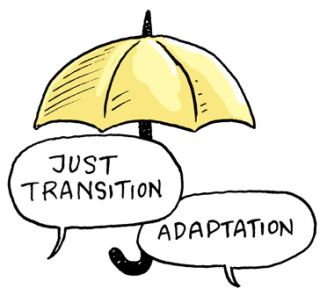
To deliver on our climate targets, Government has committed to a Green New Deal for Ireland and a Just Transition in the Programme for Government.
One of the fundamental principles of a Just Transition is to leave no people, communities, economic sectors or regions behind as we transition to a low carbon future. Transition is not just about reducing emissions. This is just one part. It is also about transforming our society and our economy, and investing in effective and integrated social protection systems, education, training and lifelong learning, childcare, out of school care, health care, long term care and other quality services, Social investment must be a top priority of transition because it is this social investment that will support those people, communities, sectors and regions as we make the difficult transition to a carbon-neutral economy, transforming how our economy and society operates.
The coming decade will be one of transformation as we try to meet our climate goals. There are some specific policies that Social Justice Ireland has consistently advocated for, that would support us in meeting these targets in the years ahead. These are:
- Set ambitious emissions reduction targets for 2030 and ensure sufficient resources to support implementation of these targets;
- Adopt targets and a reporting system for each of the Sustainable Development Goals;
- Integrate a Sustainable Development Framework into economic policy;
- Introduce a strategy for Ireland that includes the principles of the circular economy and cradle-to-cradle development;
- Introduce shadow national accounts, and assign value to natural capital and ecosystems in our national accounting systems;
- Develop a comprehensive mitigation and transition programme to support communities and people in the transition to a low carbon society;
- Develop a progressive and equitable environmental taxation system;
- Develop a new National Index of Progress encompassing environmental and social indicators of progress as well as economic ones;
- Develop a Just Transition Dialogue structure at regional and national level.